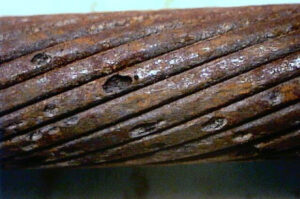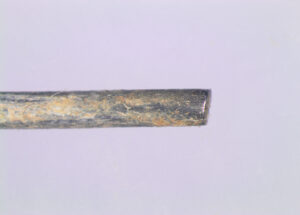Downhole wellbore environments can contain some nasty, corrosive fluids and gases, most commonly Hydrogen Sulphide and Carbon Dioxide. Hydrogen Sulphide (H2S) aggressively attacks the iron in metal, causing pitting and stress cracking, as depicted in the picture below.

In the case of a standard GIPS wireline (Galvanized Improved Plow Steel), the H2S initially reacts with the zinc coating (galvanization) and then attacks the steel wire. As shown below, the wire can become as brittle as a glass rod in high enough concentrations.

Under these circumstances, it can be challenging to retrieve the cable because the armor strands can break as they go over the sheave or through the flow tubes, resulting in the possibility of dropping tools downhole. In addition, on rare occasions, the H2S will permeate the plastic and quickly destroy the copper conductor, resulting in an electrical short of the cable. Most of us have either heard or experienced stories similar to this. The age-old questions include: 1) Where can I use a GIPS cable, and 2) When do I have to use a sour service alloy cable?

Broken armor wire from H2S embrittlement
Most wire manufacturers will tell you there is no safe limit for using a GIPS wire in a sour gas well, which is a good recommendation. However, we all know that GIPS cables are used regularly in wells containing low amounts of H2S and other corrosive conditions in the oil and gas industry. Under corrosive conditions, it is imperative to use a corrosion inhibitor to protect the cable. Operating a GIPS cable under any corrosive conditions is typically done in cases where the wireline operators are familiar with the field and have seen little or no effect on the structural integrity of the wireline. Again, the question arises: How do I know that without the experience?
This question is difficult to answer due to the many factors influencing how corrosive the fluids in a particular well will be. The factors in the list below accelerate the chemical reaction. Together, many act as a catalyst, increasing the corrosive nature of the fluid or gas.
▪ H2S (ppm)
▪ Chlorides (ppm)
▪ CO2 (%)
▪ Wellbore Temperature
▪ Exposure Time
▪ Wellbore Pressure
▪ Water Cut
▪ Acid
▪ pH
There is software that can predict the corrosive nature of the fluid on a relative basis, whereby you can determine what material to use in a particular well. However, like all software, the output is only as good as the input. It is often difficult to assess current fluid analyses from a well, or the information, at best, is an educated guess based on data from nearby wells. In some cases, the information is completely inaccurate. Many times, the corrosive effects of the well will not manifest for several days, making it very difficult to go back to the well’s owner for compensation.
The most current, accurate information is essential when deciding whether to use a GIPS cable. If you trust the information, some “old school rules of thumb” may be used. Typically, the people using these “rules of thumb” have some experiential knowledge that compliments the formulae.
Below, the two most common “rules of thumb” are noted separately for H2S and CO2:
CONCENTRATION OF H2S
If H2S (ppm) X BHP = 0.05 or greater do not use GIPS
Example:
H2S = 8ppm = .000008 or 8 x 10 -6
Bottom Hole Pressure = 6,000 psi
TEST: 0.000008 x 6,000 = 0.048
In this example, a GIPS cable may be suitable.
CONCENTRATION OF CO2
If Percent CO2 x BHP(psi) = 130 or greater do not use GIPS
Example:
CO2 = 2% = 0.02
Bottom Hole Pressure = 6,000 psi
TEST: 0.02 x 6,000 = 120
In this example, a GIPS cable may be suitable.
Note: Remember that these “rules of thumb” do not consider all of the factors discussed earlier and should only be used in conjunction with field knowledge. We strongly recommend using good protective grease on a well-seasoned line if using a GIPS cable in any corrosive environment.
The armor wires of wireline cable typically come in four materials:
● GIPS
● S77 (UNS S31277)
● S75 (UNS N08926)
● MP35 (UNS R30035)
GIPS is your standard everyday wireline, while S75 and S77 are alloy lines containing a smaller amount of iron, making them less vulnerable to attack by corrosive fluids and gasses. MP35 is an alloy with almost no iron and is highly resilient to most hostile chemicals found in downhole oil and gas environments.
All sour service cables use a nickel-plated copper conductor, which is very resistant to corrosive fluids. You must select a sour service cable if you cannot use a GIPS cable. Selecting the appropriate material for sour service lines is best done by applying a quality software program combined with personnel experienced with sour service cables and their application.
Fitting with the topic, we provide a disclaimer: This article’s information is purely advisory. In no event shall FET|Quality Wireline or its employees be liable for any damages, including but not limited to consequential damages arising from or in connection with any person’s use of this technical bulletin.



